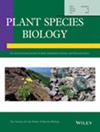Spatial heterogeneity of fire and flooding patterns can support higher diversity of floral functional traits in an indigenous‐managed landscape
IF 1.3
4区 生物学
Q4 ECOLOGY
引用次数: 0
Abstract
In tropical wetlands, in addition to flooding, fire also contributes to the structure of biodiversity across environmental gradients. In fire‐prone ecosystems, flower‐rich fire refuges can be maintained by a seasonal patch‐burning mosaic. Here, we evaluate how a set of floral traits that influence and are related to the pollination systems of tree and non‐tree species varies in response to spatial patterns of fire frequency in a landscape with floodable and flood‐free areas. We classified the sampled species according to flower size, color, shape, symmetry, floral resource, type of pollination units, flowering duration, and anthesis time and compared them between floodable and flood‐free areas with high, moderate, or low fire frequency. We analyzed the functional richness in response to landscape metrics related to spatial patterns of fire frequency. The composition of floral traits of non‐tree species was stable, while tree species differed among fire frequency classes, especially in floodable areas. Many floral traits of tree species are ecological indicators, especially in floodable areas with high fire frequency. In contrast, among non‐tree species, only floral tissues as resources for pollinator were related to flood‐free areas with moderate/high fire frequency. The floral functional richness of the tree species positively linked with the modified Simpson diversity index, and for both trees and non‐trees, it negatively associated with the homogenization of the fire frequency (e.g., connectance based on probability that two adjacent sites belong to the same fire frequency class was negatively related to the functional richness of floral traits). These results demonstrate that homogenization of fire frequency in the landscape decreases the functional richness. Patches with different combinations of fire frequency and flood regime can support a shared set of floral traits besides those specifically related to a particular regime. The spatial heterogeneity of fire and flood patterns in wetlands needs to be preserved to support a higher diversity of pollination systems mediated by functional complementarity between the flowers of the tree and non‐tree species.火灾和洪水模式的空间异质性可支持土著人管理的景观中花卉功能特征的更高多样性
在热带湿地,除了洪水之外,火灾也有助于形成跨环境梯度的生物多样性结构。在火灾易发的生态系统中,花卉丰富的火灾避难所可以通过季节性斑块燃烧镶嵌来维持。在此,我们评估了在可淹水区和无淹水区的景观中,影响树木和非树木物种授粉系统并与之相关的一系列花卉特征是如何随火灾频率的空间模式而变化的。我们根据花的大小、颜色、形状、对称性、花资源、授粉单位类型、花期和花期对采样物种进行了分类,并在火灾频率高、中、低的易涝区和无涝区之间进行了比较。我们分析了与火灾频率空间模式相关的景观指标对功能丰富度的影响。非树种的花特征组成是稳定的,而树种在不同火灾频率等级之间存在差异,尤其是在易涝地区。树种的许多花卉特征是生态指标,尤其是在火灾频率较高的易淹地区。相比之下,在非乔木物种中,只有作为授粉者资源的花组织与中度/高度火灾频率的无洪涝区有关。乔木物种的花卉功能丰富度与修正的辛普森多样性指数呈正相关,而对于乔木和非乔木物种而言,则与火灾频率的同质化呈负相关(例如,基于相邻两个地点属于同一火灾频率等级的概率的连接度与花卉性状的功能丰富度呈负相关)。这些结果表明,景观中火烧频率的同质化会降低功能的丰富性。不同火烧频率和洪水水系组合的斑块除了支持与特定水系特别相关的花卉性状外,还能支持一系列共同的花卉性状。需要保留湿地中火灾和洪水模式的空间异质性,以支持由乔木和非乔木物种花卉之间的功能互补性介导的授粉系统的更高多样性。
本文章由计算机程序翻译,如有差异,请以英文原文为准。
求助全文
约1分钟内获得全文
求助全文
来源期刊

Plant Species Biology
生物-生态学
CiteScore
2.70
自引率
14.30%
发文量
36
审稿时长
>12 weeks
期刊介绍:
Plant Species Biology is published four times a year by The Society for the Study of Species Biology. Plant Species Biology publishes research manuscripts in the fields of population biology, pollination biology, evolutionary ecology, biosystematics, co-evolution, and any other related fields in biology. In addition to full length papers, the journal also includes short research papers as notes and comments. Invited articles may be accepted or occasion at the request of the Editorial Board. Manuscripts should contain new results of empirical and/or theoretical investigations concerning facts, processes, mechanisms or concepts of evolutionary as well as biological phenomena. Papers that are purely descriptive are not suitable for this journal. Notes & comments of the following contents will not be accepted for publication: Development of DNA markers. The journal is introducing ''Life history monographs of Japanese plant species''. The journal is dedicated to minimizing the time between submission, review and publication and to providing a high quality forum for original research in Plant Species Biology.
 求助内容:
求助内容: 应助结果提醒方式:
应助结果提醒方式:


